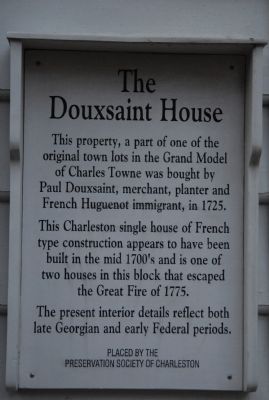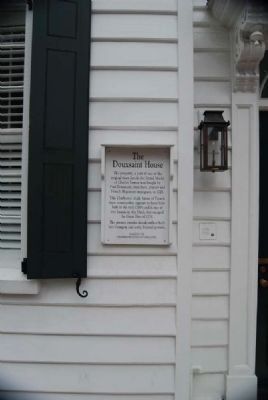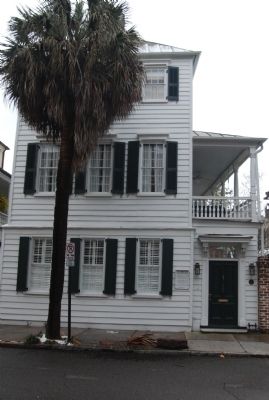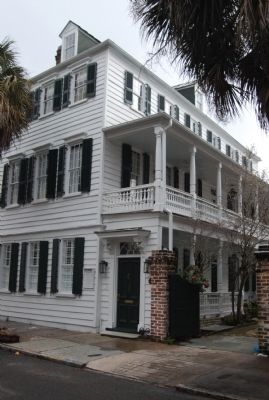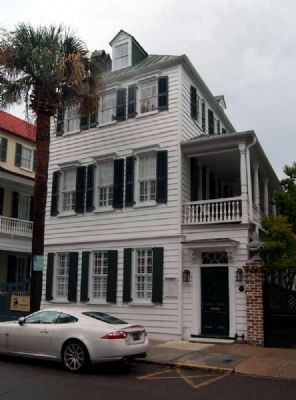French Quarter in Charleston in Charleston County, South Carolina — The American South (South Atlantic)
The Douxsaint House
original town lots in the Grand Model
of Charles Towne was bought by
Paul Douxsaint, merchant, planter, and
French Huguenot immigrant, in 1725.
The Charleston single house of French
type construction appears to have been
built in the mid 1700’s and is one of
two houses in this block that escaped
the Great Fire of 1775.
The present interior details reflect both
late Georgian and early Federal periods.
Erected by Preservation Society of Charleston.
Topics and series. This historical marker is listed in this topic list: Colonial Era. In addition, it is included in the South Carolina, Preservation Society of Charleston series list. A significant historical year for this entry is 1725.
Location. 32° 46.668′ N, 79° 55.758′ W. Marker is in Charleston, South Carolina, in Charleston County. It is in the French Quarter. Marker is at the intersection of Church Street and Chalmers Street, on the right when traveling north on Church Street. Touch for map. Marker is at or near this postal address: 132 Church Street, Charleston SC 29401, United States of America. Touch for directions.
Other nearby markers. At least 10 other markers are within walking distance of this marker. Huguenot Church (within shouting distance of this marker); Johnson's Row (within shouting distance of this marker); Slave Trading Complex (within shouting distance of this marker); Bible Depository (about 300 feet away, measured in a direct line); The Footlight Players Workshop (about 300 feet away); The Grand Lodge of Ancient Freemasons of South Carolina (about 300 feet away); 54 Queen Street (about 300 feet away); William A. Giles (about 300 feet away); a different marker also named Slave Trading Complex (about 300 feet away); The Society of the Cincinnati of the State of South Carolina (about 300 feet away). Touch for a list and map of all markers in Charleston.
Also see . . . Charleston Single House. The Charleston Single House is the architectural style most associated with Charleston, South Carolina. (Submitted on October 6, 2011, by Brian Scott of Anderson, South Carolina.)
Additional commentary.
1. Douxsaint-Macaulay House, 132 Church Street
Although this swelling has a plaque denoting its construction by the French Huguenot Paul Douxsaint in about 1726, that structure apparently burned in the fire of 1796. The exterior of the building, with its beaded weatherboarding, nine-over-nine windows with narrow muntins, and dormered hipped roof, follows the molding patterns of the early-Federal period. Most of the interior retains late-eighteenth-century wainscoting and mantels, although several rooms have have late-nineteenth-century alterations. The property retains an original, separated kitchen-laundry dependency at the rear, and brickwork on this structure with dogtooth cornicing relates to the post-Revolutionary period as well. In the nineteenth century Daniel Macaulay, a member of one of Charleston's leading Scottish merchant families, owned and occupied the dwelling. (Source: The Buildings of Charleston: A Guide to the City's Architecture by Jonathan H. Poston (1997) pg 84.)
— Submitted October 6, 2011, by Brian Scott of Anderson, South Carolina.
Credits. This page was last revised on February 16, 2023. It was originally submitted on February 15, 2010, by Michael Sean Nix of Spartanburg, South Carolina. This page has been viewed 1,735 times since then and 163 times this year. Photos: 1. submitted on February 15, 2010, by Michael Sean Nix of Spartanburg, South Carolina. 2. submitted on October 6, 2011, by Brian Scott of Anderson, South Carolina. 3, 4. submitted on February 15, 2010, by Michael Sean Nix of Spartanburg, South Carolina. 5. submitted on October 6, 2011, by Brian Scott of Anderson, South Carolina. • Craig Swain was the editor who published this page.
